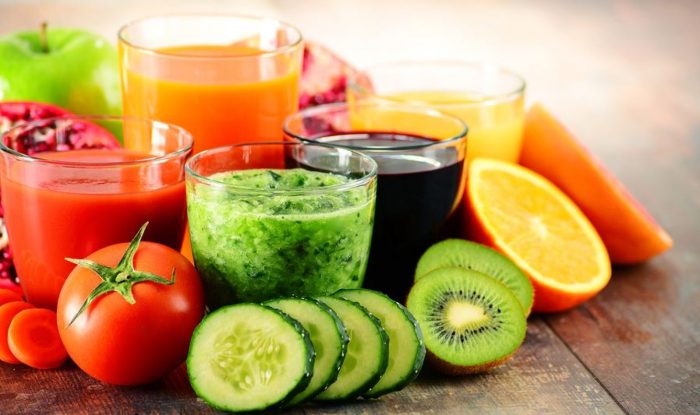How to do a juice diet is a question many ask, seeking a quick path to better health or weight loss. Juice diets involve consuming only fresh fruit and vegetable juices, often for a short period, aiming to cleanse the body and improve overall well-being. While juice diets can offer a temporary boost in nutrient intake and energy, it’s crucial to understand the potential risks and benefits before embarking on such a regimen.
This guide will delve into the intricacies of juice diets, covering everything from planning and preparation to incorporating them into a healthy lifestyle. We’ll explore the different types of juice diets, provide sample plans, and offer essential tips for a safe and successful juicing journey.
Understanding Juice Diets: How To Do A Juice Diet
A juice diet involves consuming only freshly squeezed fruit and vegetable juices for a specific period. This approach often aims to detoxify the body, promote weight loss, or improve overall health.
Potential Benefits of Juice Diets
Juice diets can offer some potential benefits, though it’s crucial to understand that these benefits are often short-term and may not be sustainable long-term.
- Increased Fruit and Vegetable Intake: Juice diets encourage the consumption of fruits and vegetables, which are rich in essential vitamins, minerals, and antioxidants.
- Improved Digestion: Juices can be easier to digest than whole fruits and vegetables, especially for individuals with digestive issues.
- Weight Loss: Juice diets often lead to calorie restriction, which can result in short-term weight loss. However, this weight loss is often primarily due to water loss and may not be sustainable.
Types of Juice Diets
Juice diets vary in duration, ingredient selection, and overall approach. Some common types include:
- Master Cleanse: This diet, popularized by the book “The Master Cleanse,” involves consuming a lemon-based drink, maple syrup, and cayenne pepper for 10 days.
- Juice Fasting: This approach involves consuming only juices for a specified period, typically ranging from a few days to a week. It often focuses on specific types of juices, such as green juices or fruit juices.
- Juice Cleanses: Similar to juice fasting, juice cleanses often involve a pre-determined schedule of juices for a set period, typically 3-7 days.
Risks and Drawbacks of Juice Diets
While juice diets can offer potential benefits, they also come with several risks and drawbacks:
- Nutrient Deficiency: Juice diets can lead to nutrient deficiencies because they lack essential nutrients found in whole foods, such as protein, fiber, and healthy fats.
- Blood Sugar Fluctuations: Juice diets can cause blood sugar fluctuations due to the high sugar content in fruit juices.
- Dehydration: Juice diets can lead to dehydration if not accompanied by sufficient water intake.
- Gastrointestinal Issues: Some individuals may experience gastrointestinal issues, such as diarrhea or bloating, when consuming large amounts of juice.
- Unsustainability: Juice diets are often unsustainable in the long term, as they are restrictive and may not provide adequate nutrition.
Planning a Juice Diet
Planning a juice diet requires careful consideration to ensure it’s safe and effective. It involves selecting the right fruits and vegetables, creating a balanced juice plan, and understanding the potential risks and benefits.
Choosing the Right Fruits and Vegetables, How to do a juice diet
Selecting the right fruits and vegetables is crucial for a balanced and nutritious juice diet. Consider the following factors:
- Nutrient Density: Prioritize fruits and vegetables rich in essential vitamins, minerals, and antioxidants. These include leafy greens like spinach and kale, citrus fruits like oranges and grapefruits, berries like blueberries and strawberries, and root vegetables like carrots and beets.
- Fiber Content: While juice provides some fiber, it’s essential to include fruits and vegetables with higher fiber content to promote digestive health and prevent blood sugar spikes. Good choices include apples, pears, and broccoli.
- Variety: Aim for a diverse range of fruits and vegetables to ensure you’re getting a wide array of nutrients.
- Seasonality: Opt for seasonal fruits and vegetables for optimal flavor and nutrient content.
Creating a Balanced Juice Plan
A balanced juice plan should include a variety of fruits and vegetables, ensuring you’re getting essential nutrients and staying hydrated.
- Start with a Green Juice Base: Include leafy greens like spinach, kale, or romaine lettuce as the foundation for your juices. These greens provide essential vitamins, minerals, and antioxidants.
- Add Fruits for Sweetness and Flavor: Incorporate fruits like apples, berries, or citrus fruits to enhance the taste and provide natural sweetness.
- Include Root Vegetables for Added Nutrients: Root vegetables like carrots, beets, or ginger can add flavor and contribute to the nutritional value of your juices.
- Consider Adding Superfoods: Superfoods like chia seeds, flaxseeds, or spirulina can further enhance the nutritional profile of your juices.
Consulting a Healthcare Professional
Consulting a healthcare professional before starting a juice diet is essential, especially if you have any underlying health conditions.
“A juice diet can be a valuable tool for detoxification and weight loss, but it’s important to consult with a healthcare professional to ensure it’s safe and appropriate for your individual needs.”
- Health Conditions: Individuals with diabetes, kidney disease, or other health conditions should consult their doctor before embarking on a juice diet.
- Medication Interactions: Some medications may interact with certain fruits and vegetables, so it’s important to discuss this with your doctor.
- Nutritional Deficiencies: A juice diet may not provide all the essential nutrients your body needs, so it’s important to monitor your nutrient intake and consider supplementation if necessary.
Sample Juice Diet Plans
Juice diets are often short-term plans, usually lasting for a few days to a week. These plans typically involve consuming only freshly made juices from fruits and vegetables, providing a concentrated source of vitamins, minerals, and antioxidants. While juice diets can offer a quick way to detoxify and cleanse your body, it’s crucial to remember that they are not a long-term solution for weight loss or overall health.
Three-Day Juice Diet Plan
This plan offers a sample three-day juice diet plan, incorporating a variety of fruits and vegetables to provide essential nutrients. It’s essential to listen to your body and adjust the plan as needed.
- Day 1
- Morning (8:00 AM): Green Detox Juice: 1 cup spinach, 1/2 cup cucumber, 1/2 apple, 1/4 lemon, 1/2 inch ginger
- Mid-Morning (11:00 AM): Citrus Burst Juice: 1 orange, 1/2 grapefruit, 1/4 lemon, 1/2 cup pineapple
- Lunch (1:00 PM): Beetroot and Berry Blast: 1 beetroot, 1/2 cup strawberries, 1/4 cup blueberries, 1/4 cup raspberries
- Afternoon (4:00 PM): Carrot and Ginger Zing: 2 carrots, 1/2 inch ginger, 1/4 apple
- Evening (7:00 PM): Tropical Delight: 1/2 mango, 1/2 papaya, 1/2 banana, 1/4 pineapple
- Day 2
- Morning (8:00 AM): Green Power Juice: 1 cup kale, 1/2 cucumber, 1/2 apple, 1/4 lemon, 1/2 inch ginger
- Mid-Morning (11:00 AM): Berry and Banana Boost: 1/2 cup strawberries, 1/4 cup blueberries, 1/4 cup raspberries, 1 banana
- Lunch (1:00 PM): Beetroot and Apple Refresher: 1 beetroot, 1 apple, 1/4 cup orange juice
- Afternoon (4:00 PM): Carrot and Celery Cleanse: 2 carrots, 2 celery stalks, 1/4 apple
- Evening (7:00 PM): Mango and Pineapple Tango: 1/2 mango, 1/2 pineapple, 1/4 cup coconut water
- Day 3
- Morning (8:00 AM): Kale and Apple Smoothie: 1 cup kale, 1 apple, 1/2 banana, 1/4 cup almond milk
- Mid-Morning (11:00 AM): Citrus and Ginger Zing: 1 orange, 1/2 grapefruit, 1/4 lemon, 1/2 inch ginger
- Lunch (1:00 PM): Strawberry and Spinach Delight: 1 cup spinach, 1/2 cup strawberries, 1/4 cup raspberries, 1/4 cup almond milk
- Afternoon (4:00 PM): Carrot and Celery Cleanse: 2 carrots, 2 celery stalks, 1/4 apple
- Evening (7:00 PM): Banana and Berry Bliss: 1 banana, 1/2 cup strawberries, 1/4 cup blueberries, 1/4 cup raspberries
Seven-Day Juice Diet Plan
This plan provides a seven-day juice diet plan with a focus on incorporating a variety of fruits and vegetables. This plan offers a broader spectrum of nutrients while ensuring a balanced intake.
- Day 1
- Morning (8:00 AM): Green Power Juice: 1 cup kale, 1/2 cucumber, 1/2 apple, 1/4 lemon, 1/2 inch ginger
- Mid-Morning (11:00 AM): Citrus Burst Juice: 1 orange, 1/2 grapefruit, 1/4 lemon, 1/2 cup pineapple
- Lunch (1:00 PM): Beetroot and Berry Blast: 1 beetroot, 1/2 cup strawberries, 1/4 cup blueberries, 1/4 cup raspberries
- Afternoon (4:00 PM): Carrot and Ginger Zing: 2 carrots, 1/2 inch ginger, 1/4 apple
- Evening (7:00 PM): Tropical Delight: 1/2 mango, 1/2 papaya, 1/2 banana, 1/4 pineapple
- Day 2
- Morning (8:00 AM): Green Detox Juice: 1 cup spinach, 1/2 cup cucumber, 1/2 apple, 1/4 lemon, 1/2 inch ginger
- Mid-Morning (11:00 AM): Berry and Banana Boost: 1/2 cup strawberries, 1/4 cup blueberries, 1/4 cup raspberries, 1 banana
- Lunch (1:00 PM): Beetroot and Apple Refresher: 1 beetroot, 1 apple, 1/4 cup orange juice
- Afternoon (4:00 PM): Carrot and Celery Cleanse: 2 carrots, 2 celery stalks, 1/4 apple
- Evening (7:00 PM): Mango and Pineapple Tango: 1/2 mango, 1/2 pineapple, 1/4 cup coconut water
- Day 3
- Morning (8:00 AM): Kale and Apple Smoothie: 1 cup kale, 1 apple, 1/2 banana, 1/4 cup almond milk
- Mid-Morning (11:00 AM): Citrus and Ginger Zing: 1 orange, 1/2 grapefruit, 1/4 lemon, 1/2 inch ginger
- Lunch (1:00 PM): Strawberry and Spinach Delight: 1 cup spinach, 1/2 cup strawberries, 1/4 cup raspberries, 1/4 cup almond milk
- Afternoon (4:00 PM): Carrot and Celery Cleanse: 2 carrots, 2 celery stalks, 1/4 apple
- Evening (7:00 PM): Banana and Berry Bliss: 1 banana, 1/2 cup strawberries, 1/4 cup blueberries, 1/4 cup raspberries
- Day 4
- Morning (8:00 AM): Green Power Juice: 1 cup kale, 1/2 cucumber, 1/2 apple, 1/4 lemon, 1/2 inch ginger
- Mid-Morning (11:00 AM): Citrus Burst Juice: 1 orange, 1/2 grapefruit, 1/4 lemon, 1/2 cup pineapple
- Lunch (1:00 PM): Beetroot and Berry Blast: 1 beetroot, 1/2 cup strawberries, 1/4 cup blueberries, 1/4 cup raspberries
- Afternoon (4:00 PM): Carrot and Ginger Zing: 2 carrots, 1/2 inch ginger, 1/4 apple
- Evening (7:00 PM): Tropical Delight: 1/2 mango, 1/2 papaya, 1/2 banana, 1/4 pineapple
- Day 5
- Morning (8:00 AM): Green Detox Juice: 1 cup spinach, 1/2 cup cucumber, 1/2 apple, 1/4 lemon, 1/2 inch ginger
- Mid-Morning (11:00 AM): Berry and Banana Boost: 1/2 cup strawberries, 1/4 cup blueberries, 1/4 cup raspberries, 1 banana
- Lunch (1:00 PM): Beetroot and Apple Refresher: 1 beetroot, 1 apple, 1/4 cup orange juice
- Afternoon (4:00 PM): Carrot and Celery Cleanse: 2 carrots, 2 celery stalks, 1/4 apple
- Evening (7:00 PM): Mango and Pineapple Tango: 1/2 mango, 1/2 pineapple, 1/4 cup coconut water
- Day 6
- Morning (8:00 AM): Kale and Apple Smoothie: 1 cup kale, 1 apple, 1/2 banana, 1/4 cup almond milk
- Mid-Morning (11:00 AM): Citrus and Ginger Zing: 1 orange, 1/2 grapefruit, 1/4 lemon, 1/2 inch ginger
- Lunch (1:00 PM): Strawberry and Spinach Delight: 1 cup spinach, 1/2 cup strawberries, 1/4 cup raspberries, 1/4 cup almond milk
- Afternoon (4:00 PM): Carrot and Celery Cleanse: 2 carrots, 2 celery stalks, 1/4 apple
- Evening (7:00 PM): Banana and Berry Bliss: 1 banana, 1/2 cup strawberries, 1/4 cup blueberries, 1/4 cup raspberries
- Day 7
- Morning (8:00 AM): Green Power Juice: 1 cup kale, 1/2 cucumber, 1/2 apple, 1/4 lemon, 1/2 inch ginger
- Mid-Morning (11:00 AM): Citrus Burst Juice: 1 orange, 1/2 grapefruit, 1/4 lemon, 1/2 cup pineapple
- Lunch (1:00 PM): Beetroot and Berry Blast: 1 beetroot, 1/2 cup strawberries, 1/4 cup blueberries, 1/4 cup raspberries
- Afternoon (4:00 PM): Carrot and Ginger Zing: 2 carrots, 1/2 inch ginger, 1/4 apple
- Evening (7:00 PM): Tropical Delight: 1/2 mango, 1/2 papaya, 1/2 banana, 1/4 pineapple
Juice Diet Plan for Weight Loss
This plan focuses on calorie intake and portion sizes, aiming to promote weight loss. It’s important to note that juice diets for weight loss are not sustainable long-term solutions.
- Day 1
- Morning (8:00 AM): Green Power Juice: 1 cup kale, 1/2 cucumber, 1/2 apple, 1/4 lemon, 1/2 inch ginger (150 calories)
- Mid-Morning (11:00 AM): Citrus Burst Juice: 1 orange, 1/2 grapefruit, 1/4 lemon, 1/2 cup pineapple (120 calories)
- Lunch (1:00 PM): Beetroot and Berry Blast: 1 beetroot, 1/2 cup strawberries, 1/4 cup blueberries, 1/4 cup raspberries (100 calories)
- Afternoon (4:00 PM): Carrot and Ginger Zing: 2 carrots, 1/2 inch ginger, 1/4 apple (100 calories)
- Evening (7:00 PM): Tropical Delight: 1/2 mango, 1/2 papaya, 1/2 banana, 1/4 pineapple (180 calories)
- Day 2
- Morning (8:00 AM): Green Detox Juice: 1 cup spinach, 1/2 cup cucumber, 1/2 apple, 1/4 lemon, 1/2 inch ginger (120 calories)
- Mid-Morning (11:00 AM): Berry and Banana Boost: 1/2 cup strawberries, 1/4 cup blueberries, 1/4 cup raspberries, 1 banana (150 calories)
- Lunch (1:00 PM): Beetroot and Apple Refresher: 1 beetroot, 1 apple, 1/4 cup orange juice (130 calories)
- Afternoon (4:00 PM): Carrot and Celery Cleanse: 2 carrots, 2 celery stalks, 1/4 apple (110 calories)
- Evening (7:00 PM): Mango and Pineapple Tango: 1/2 mango, 1/2 pineapple, 1/4 cup coconut water (160 calories)
- Day 3
- Morning (8:00 AM): Kale and Apple Smoothie: 1 cup kale, 1 apple, 1/2 banana, 1/4 cup almond milk (180 calories)
- Mid-Morning (11:00 AM): Citrus and Ginger Zing: 1 orange, 1/2 grapefruit, 1/4 lemon, 1/2 inch ginger (100 calories)
- Lunch (1:00 PM): Strawberry and Spinach Delight: 1 cup spinach, 1/2 cup strawberries, 1/4 cup raspberries, 1/4 cup almond milk (140 calories)
- Afternoon (4:00 PM): Carrot and Celery Cleanse: 2 carrots, 2 celery stalks, 1/4 apple (110 calories)
- Evening (7:00 PM): Banana and Berry Bliss: 1 banana, 1/2 cup strawberries, 1/4 cup blueberries, 1/4 cup raspberries (160 calories)
Note: These calorie estimates are approximate and may vary depending on the specific ingredients used.
Essential Tips for Juice Dieting
A juice diet can be an effective way to cleanse your body and lose weight, but it’s important to do it right to maximize its benefits and minimize any potential risks. Here are some essential tips to ensure a successful and safe juice diet experience.
Preparing Juices
Preparing juices is an integral part of a juice diet. The quality of your juices directly affects the nutritional value and overall effectiveness of your diet. Here are some tips for preparing juices:
- Choose the right blender: A high-speed blender is ideal for making smooth and consistent juices. A powerful blender ensures that all ingredients are thoroughly blended, resulting in a smoother and more palatable juice.
- Use fresh, high-quality ingredients: Opt for organic fruits and vegetables whenever possible to avoid pesticide residues and maximize nutritional value. Fresh ingredients are packed with nutrients and enzymes that are essential for your health and well-being.
- Experiment with different combinations: Don’t be afraid to get creative with your juice recipes. Explore different flavor combinations to find what you enjoy and ensure variety in your diet.
- Add healthy fats: While a juice diet primarily focuses on fruits and vegetables, incorporating healthy fats like avocado, flaxseed oil, or chia seeds can enhance satiety and provide essential nutrients.
- Consider adding protein powder: Adding a scoop of protein powder to your juices can help stabilize blood sugar levels and prevent hunger pangs. Whey protein, soy protein, or pea protein are all good options.
Staying Hydrated
Maintaining adequate hydration is crucial during a juice diet, as it helps flush out toxins, supports digestion, and prevents dehydration.
- Drink plenty of water: Aim for at least 8 glasses of water per day, especially during the initial stages of the juice diet when your body is adjusting to the change in diet.
- Consider herbal teas: Herbal teas like ginger, chamomile, or peppermint can aid digestion, soothe the stomach, and contribute to your overall hydration.
- Limit sugary drinks: While fruit juices provide some nutrients, they are also high in natural sugars. Limiting your intake of sugary drinks, including fruit juices, is important for maintaining blood sugar levels and preventing cravings.
Exercise and Physical Activity
While a juice diet is primarily focused on nutrition, incorporating regular exercise and physical activity can enhance your overall well-being and complement the benefits of the diet.
- Engage in light to moderate exercise: Walking, yoga, or swimming are good options for maintaining your fitness level and supporting your body’s detoxification process.
- Listen to your body: If you feel weak or fatigued, reduce the intensity or duration of your workouts. Rest and recovery are crucial during a juice diet.
- Consult a healthcare professional: If you have any underlying health conditions, it’s essential to consult with a doctor before starting a juice diet and engaging in any exercise program.
Incorporating Juice Diets into a Healthy Lifestyle
Juice diets can be a valuable tool for short-term detoxification or weight loss, but it’s crucial to understand that they are not a sustainable long-term solution. Integrating juicing into a balanced and healthy lifestyle is key to reaping its benefits while avoiding potential downsides.
Transitioning Back to Solid Foods
After completing a juice diet, gradually transitioning back to solid foods is essential to avoid digestive discomfort and ensure proper nutrient absorption. This process should be slow and deliberate, starting with light, easily digestible foods and gradually incorporating more complex options.
- Start with broth-based soups, cooked vegetables, and fruits that are easy to digest.
- Gradually introduce whole grains, lean proteins, and healthy fats as your body adjusts.
- Listen to your body and pay attention to any signs of digestive upset, adjusting your intake accordingly.
Maintaining a Healthy Lifestyle
A juice diet is just one aspect of a healthy lifestyle. After completing a juice cleanse, it’s important to focus on maintaining healthy habits that promote long-term well-being.
- Prioritize whole foods: Base your diet on fruits, vegetables, whole grains, lean proteins, and healthy fats.
- Stay hydrated: Water is crucial for overall health and helps flush out toxins. Aim for 8 glasses of water daily.
- Engage in regular physical activity: Exercise helps boost metabolism, improves mood, and supports overall health.
- Get enough sleep: Adequate sleep is essential for physical and mental well-being. Aim for 7-9 hours of quality sleep per night.
- Manage stress: Stress can have a negative impact on health. Practice stress-management techniques like yoga, meditation, or spending time in nature.
Incorporating Juicing into a Long-Term Healthy Eating Plan
Juicing can be a valuable part of a healthy eating plan, but it should not replace whole foods. Instead, consider incorporating juicing as a supplement to a balanced diet.
- Start with a small amount of juice: Begin with one juice per day and gradually increase as needed.
- Choose fresh, organic ingredients: Opt for fresh, organic produce whenever possible to ensure the highest quality nutrients.
- Include a variety of fruits and vegetables: Aim for a mix of different colors and types of produce to obtain a wide range of nutrients.
- Don’t juice everything: Focus on juicing fruits and vegetables that are rich in antioxidants, vitamins, and minerals, while still enjoying whole foods for fiber and other nutrients.
- Listen to your body: Pay attention to how your body responds to juicing and adjust your intake accordingly.
Last Recap

In conclusion, a juice diet can be a powerful tool for short-term detoxification and a quick boost in nutrient intake. However, it’s essential to approach juice diets with caution, considering the potential risks and consulting a healthcare professional before embarking on any such plan. Remember, a juice diet should be a temporary supplement to a balanced diet and an active lifestyle, not a long-term solution for weight loss or overall health. By following the guidelines Artikeld in this guide, you can enjoy the potential benefits of juicing while prioritizing your health and well-being.
Popular Questions
Is it safe to do a juice diet for a long time?
No, it’s not recommended to follow a juice diet for extended periods. Long-term juice diets can lead to nutrient deficiencies and other health issues.
What are the best fruits and vegetables for juicing?
Choose fruits and vegetables high in vitamins, minerals, and antioxidants, such as leafy greens, citrus fruits, berries, and root vegetables.
Can I exercise while on a juice diet?
It’s generally safe to exercise while on a juice diet, but listen to your body and avoid strenuous activities if you feel weak or lightheaded.
What are some healthy snacks to have between juices?
You can enjoy small portions of fruits, vegetables, nuts, or seeds between your juice meals to ensure adequate fiber and nutrient intake.
What should I do after finishing a juice diet?
Gradually reintroduce solid foods into your diet, starting with small portions of easily digestible foods like fruits, vegetables, and soups.
A juice diet can be a great way to cleanse your system and boost your energy levels. While you’re focusing on fruits and vegetables, don’t forget about adding collagen to your diet, as it can help improve skin elasticity and joint health.
You can find out more about how to incorporate collagen into your daily routine by checking out this helpful guide on how to add collagen to diet. Remember, a juice diet should be done in moderation and always consult with a doctor before making any significant dietary changes.
























